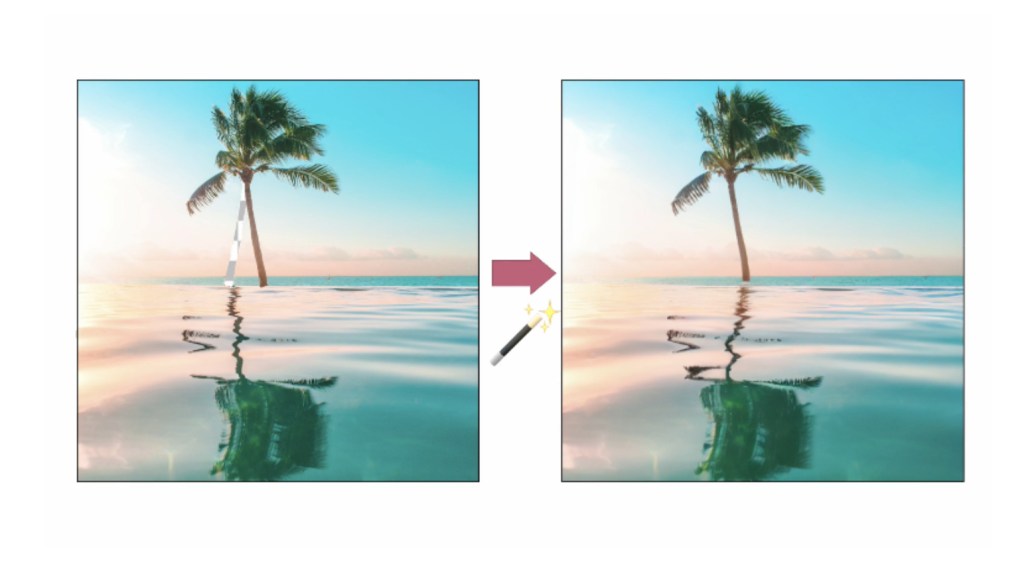Join our daily and weekly newsletters for the latest updates and exclusive content on industry-leading AI coverage. Learn More
Adobe researchers have revealed an AI model that promises to transform photo editing by harnessing the power of video data. Dubbed “Magic Fixup,” this new technology automates complex image adjustments while preserving artistic intent, potentially reshaping workflows across multiple industries.
Magic Fixup’s core innovation lies in its unique approach to training data. Unlike previous models that relied solely on static images, Adobe’s system learns from millions of video frame pairs. This novel method allows the AI to understand the nuanced ways objects and scenes change under varying conditions of light, perspective, and motion.
“We construct an image dataset in which each sample is a pair of source and target frames extracted from the same video at randomly chosen time intervals,” the researchers explain in their paper. “We warp the source frame toward the target using two motion models that mimic the expected test-time user edits.”
This video-based training enables Magic Fixup to perform edits that were previously challenging for AI systems. Users can make coarse adjustments to an image — such as repositioning objects or altering their size — using simple cut-and-paste style manipulations. The AI then refines these edits with remarkable sophistication.
“Our method transfers fine details from the original image and preserve the identity of its parts. Yet, it adapts it to the lighting and context defined by the new layout,” the paper states, highlighting the system’s ability to maintain image integrity while making significant changes.
From coarse edits to photorealistic magic: How Magic fixup works
The Magic Fixup pipeline uses two diffusion models working in parallel: a detail extractor and a synthesizer. The detail extractor processes the reference image and a noisy version of it, producing features that guide the synthesis and preserve fine details from the original image. The synthesizer then generates the output conditioned on the user’s coarse edit and the extracted details.
“Our model design explicitly enables fine detail transfer from the source frame to the generated image, while closely following the user-specified layout,” the researchers explain. This approach allows Magic Fixup to produce highly realistic results that adhere closely to the user’s intentions.
In user studies conducted by the Adobe team, Magic Fixup’s results were overwhelmingly preferred to those of existing state-of-the-art methods. “For 80% of the edits, at least 75% of the users preferred our method,” the paper reports, indicating a significant leap in output quality.
Transforming industries: The far-reaching impact of AI-powered photo editing
The implications of this technology extend far beyond simple photo touch-ups. In advertising, art directors could rapidly prototype complex visual concepts without extensive photoshoots or time-consuming manual editing. Film and television production could see streamlined visual effects workflows, potentially reducing costs and accelerating post-production timelines.
For social media influencers and content creators, Magic Fixup could level the playing field, allowing those without professional editing skills to produce polished, high-quality visuals. This democratization of advanced editing capabilities may lead to a surge in creative content across platforms, though it also raises questions about the authenticity of images in an era of easy manipulation.
The technology’s potential reaches into fields like forensics and historical preservation, where Magic Fixup could aid in the restoration and enhancement of degraded images, providing new tools for investigators and archivists alike.
However, as with any powerful AI tool, ethical concerns abound. The ease with which realistic image manipulations can be created could exacerbate issues of misinformation and digital deception. Adobe will likely face pressure to implement safeguards and possibly some form of digital watermarking to mitigate potential misuse.
The development of Magic Fixup also highlights the increasing convergence of AI and creative tools. As machine learning models become more sophisticated in understanding and manipulating visual data, the line between human and AI-generated content continues to blur. This trend is likely to spark ongoing debates about the nature of creativity and authorship in the digital age.
Collaboration over competition: Adobe’s surprising shift in AI strategy
In a surprising move that departs from its usual practices, Adobe has decided to release the research code for Magic Fixup on GitHub. This unprecedented step towards open-sourcing such advanced technology marks a major shift in Adobe’s approach to AI development. Traditionally, the company has closely guarded its proprietary algorithms and tools, making this decision particularly noteworthy in the tech and creative communities.
This openness could accelerate the development of similar technologies across the industry, potentially leading to a new generation of AI-powered creative tools. It also signals Adobe’s recognition of the value of collaborative innovation in the rapidly evolving field of AI-assisted creativity.
As the creative industry grapples with the implications of AI, Magic Fixup represents a significant milestone. It offers a glimpse into a future where the boundaries between human creativity and machine assistance are increasingly fluid. For professionals in fields ranging from graphic design to digital marketing, staying abreast of these developments will be crucial to remaining competitive in an evolving landscape.
While Adobe has not announced a specific timeline for integrating Magic Fixup into its Creative Cloud suite, the technology’s impressive performance suggests it could reach users sooner rather than later. The question now isn’t just how Magic Fixup will transform visual editing, but how this new era of collaborative AI development will redefine the very nature of digital creativity. One thing’s certain: the brush strokes of the future will be guided by an invisible, open-source hand.
Source link

